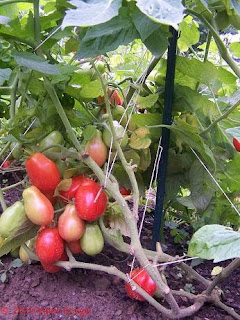It's TIME. Time for TOMATOES! It is with great relief that this summer has provided the garden with (so far) a healthy group of tomato plants with a plentiful crop ripening on the way and getting ready to keep me too busy!
Roma tomatoes are the way I grow. Why? Better for canning. When it comes to canning, and other cooking recipes, this is the tomato for you. Think about how juicy tomatoes can be- a lot of water content! When cooking down tomatoes for sauces or even for use in a salsa all that water is not very desirable. With Roma tomatoes you get more 'meat' and less water than you do with other varieties.
 |
| 2010 |
 |
| 2009 |
After the tomato famine of 2009 I think there has been great expectations for a good harvest this year. While I have read of some late blight in other areas of the Northeast and even in New York it is nothing like last year. My garden and that of everyone I know of- has been blight free (so far). Compare the two tomato patch images above. The photos are taken nearly to the day a year apart! And what a difference! Last year at this day my tomato plants were DEAD! They slowly wasted away from the notorious late blight. It started with only one sick looking plant and in days the whole crop went from lush green growth to dead rotting plants. Needless to say 2010 is already looking very good.
It was interesting when I learned that the late blight spores cannot survive the winters of the north and that spores actually migrate from the south to the north through wind- every year. So why was 2009 so bad? Last years cool and moist climate just happened to be the perfect breeding ground for blight to spread like wildfire. This year in contrast has been very much the opposite- sunny and warm.
Sunshine is the enemy of fungi. So is circulation. If you keep that in mind it now makes sense why tomatoes are traditionally staked or supported in some way to hold the plants upright (as they will sprawl everywhere if you don't train them well). There are countless ways to stake tomatoes and its always fun to see some gardeners creativity or efficiency in doing so. I've used tomato cages, but I don't like them- too weak. My technique so far has evolved from wooden stakes to U posts driven into the soil when the transplants go into the ground. As the plant grows I do two things- train and prune. I use cotton twin to gently lasso the branches to the post. After I've trained the plant to grow in the direction I want it to (UP), I take that moment to prune off all the lower leaves, especially any leaf that touches the ground. Moving from plant to plant in this manner the process is repeated every week or so until necessary.
Training or staking keeps the plant under control and off the ground improving air circulation around it in the process. Pruning encourages the redirection of energy, but it also improves the air circulation even more around the base of the plant- which is a good battle plan against blight! Another benefit is that the tomatoes are easier to see and reach when the time to pick them has come. Other blight prevention strategies are to lightly cultivate the soil around the plants (airs out the soil), and to avoid getting the foliage wet when watering (water the ground, not the leaves).
One thing I wanted to try this year, now that there are tomatoes the play with, is sun dried tomatoes. I used a recipe for 'Oven-dried tomatoes' found in Put 'Em Up by Sherri Brooks Vinton. The tomatoes (again Roma is preferable) are cut in half lengthwise and tossed in an oil (olive seems best). The slices are to be arranged with the cut side up on cookie sheets and left to slow roast in the oven at 220 until they shrivel and start to burn singe a little. Store them in the freezer in clean freezer safe jars. I used one of my mason jars I had hanging around already in the kitchen.
And you have 'sun' dried tomatoes. They look pretty authentic! I'm wondering if there is any seasoning that could be used on the tomatoes. This can be something to experiment with. In the meantime, salsa is my next tomato project.
On a tangent, I'd like to say farewell to Angie Cat, our foster cat who returned home this past week. This was my last picture of her as she accompanied me while I harvested the tomatoes photographed for this post. Misses outdoors extraordinaire will be missed for sure, but she is enjoying her family reunion from what I hear. Good luck Angie!



















